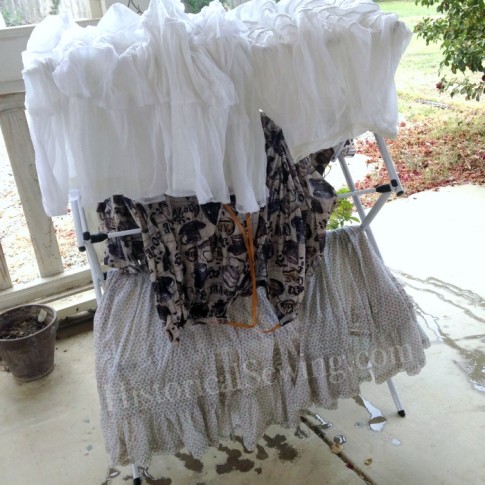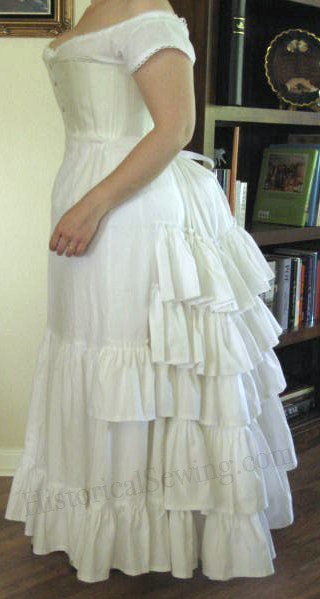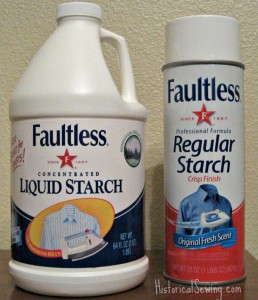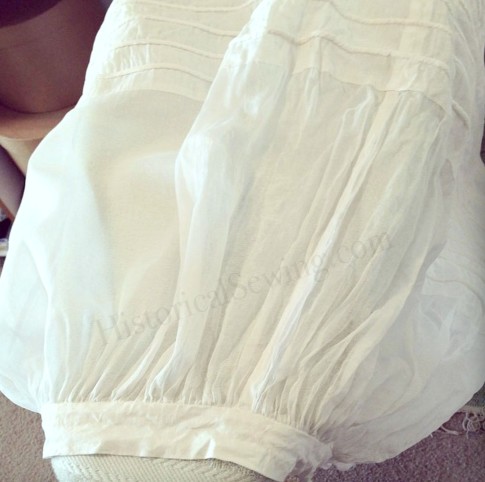
Do you starch your petticoats? Like those that are required if you want a good historical silhouette?
I’ll admit I don’t keep my petticoats freshly starched & pressed as much as I should. But I still remember the very first time I pressed a plain petticoat after starching for the first time. OMG!
That “paper finish” we all read about? Yeah…. that happened. Don’t know why it took me so long to try dip starching! When you’re ready for that Oh.my.gosh moment too, here’s the tutorial you’ll need.

Nothing can be compared to a nicely starched petticoat. Doesn’t matter if your petticoat has ruffles or is plain or has rows of cording, a starch treatment will keep it stiff, giving excellent support to the over dress. Starching also allows dust to be easily brushed off. Depending on the heaviness of your starching, it will give your petticoats that slight “rustle.” Hehe
Most of my petticoats are cotton. Ok, well, all of them except for one that’s in linen. Cotton is what you’ll find for most Victorian petticoats (as we recently discussed). And the reason is because it simply washes and starches better than other textiles. I highly recommend sticking to cotton for petticoats if you plan to starch.
Although it is not recommended to starch silk fabrics, if you have made a silk petticoat, do a test before dunking the whole garment in the wash bin. Silk petticoats are lovely and some do not necessarily need starch to stiffen.

Liquid Dip Starching
I don’t know about you, but if I’m going to take the time to starch & press my petticoats I’d rather use the best technique first, right? This happens to be soaking (aka dipping) the entire petticoat in starchy water rather than spraying starch from a can (more on that below).
You will be AMAZED at the results of dip-starching your petticoats! Honestly. I was floored. (Ok, for those of you who starched petticoats in the 1950s & 1960s you probably know all this already. Feel free to comment below on your experiences. 🙂 )
The easiest way to dip-starch your petticoat is in a large wash bin. (You can use your bathtub too but will need to clean it well afterwards.) I’ve found galvanized tubs are perfect for the job and come in various sizes. They can be found in your local hardware store – look in the garden and/or paint sections.
Note: You can starch in the washing machine but it’s at your own risk.
1. Decide on how stiff you want your petticoat to be.
Use the following proportions of water to liquid starch. Your batch can be made to any size, but keep the proportions. You will find you can make your batch small, using only a few cups of water. You only need enough to get the entire petticoat wet and soaked (thank goodness, right?).
Use the Heavy or Medium stiffness strength for historical petticoats.
Very Heavy: Full strength liquid starch (very stiff), use conservatively
Heavy: 1 part water to 1 part starch
Medium: 2 parts water to 1 part starch
Light: 4 parts water to 1 part starch
2. Dip your entire petticoat in the tub. Turn it over in the tub several times to wet it all down. Let the fibers soak in all that goodie starch water! Gently squeeze excess water out.
You’ll want to make sure you dip a *clean* petticoat or you’ll have it soaking up dirty starch water that will remain in the fibers. Eww! Starched petticoats don’t need to be washed as frequently, so wash first; then starch.
NOTE: You can continue to use the same starch water for as many petticoats as you need to stiffen. Don’t let it go to waste!
Lay flat to dry completely. A fully dried petticoat is the key when dip starching.
3. After it’s fully dry it’s time to iron your petticoat. Whenever you iron a garment to stiffen the starch or apply it, protect your ironing board with a towel.
Lightly spray your petticoat with water, only until damp. Do not soak it! You merely want to get it slightly damp to activate the starch in the fibers.
Use a hot iron on a cotton setting to press. As you iron you will see the paper finish come alive and the iron glide smoothly over the fabric. This is your OMG moment!! Enjoy! 🙂

A Quick Word on Using Spray Starch
If you are looking for a quick, light starch finish, then the spray can is for you. You can achieve a medium starch hold using the spray starch, but it takes a lot of work! Do not try to spray starch a ruffled petticoat. You will be working for 8 hours on it! Dip starch those ruffles instead. 🙂
You can begin with a dry petticoat when spray starching. However, you can also spray water very lightly on the fabric first then spray the starch. Following the can directions, spray the starch over the fabric on your ironing board. Then press. (Only spray and iron a section at a time.)
After spraying the starch, allow it to “set into” the fabric for a few seconds – no more than 30 – before ironing. This allows the starch to wrap around the fabric fibers for more stiff coverage.
Storing Your Starched Petticoats
You put in many hours creating your historical clothing items. As with all your period costumes, storage of your starched petticoats requires some thinking.
If you are using purchased chemical starch you won’t need to worry as much. Although, if you decide to go authentic and use a homemade potato/rice/corn starch, be cautioned that it will attract insects. Cedar balls or cotton balls with essential oil (peppermint, lavender or lemongrass oils recommended) are good repellants. Be careful not to store the balls actually ON the fabric but in sachet bags.
Petticoats ideally should be stored flat in a drawer or acid-free box. You could also roll them with tissue paper. Do not wrap or store petticoats (or any costume) in a plastic bag or tight plastic bin. The fabrics need to breathe.
Enjoy your freshly starched petticoats!!
Do you have another method for starching petticoats? Any vintage tricks you’ve tried that may work better? Share in the comments below!